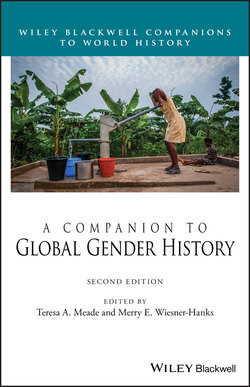Читать книгу A Companion to Global Gender History - Группа авторов - Страница 36
Circumcision, Identity, and Rites of Passage
ОглавлениеPracticed in ancient worlds, circumcision continues to be performed in the modern world around the globe. Along with people who circumcise infant boys for religious or health reasons, peoples throughout the Middle East, Northern, Western and sub‐Saharan African countries, Polynesia, and Australia have practiced male circumcision as a rite of passage. Female circumcision as a rite of passage is less often encountered, turning up in North, West, East and sub‐Saharan Africa, and in modern Egypt.
Both female and male circumcision involve altering the genitals. The alteration of the genitals signifies in multiple ways, but one of the most meaningful is identity: identity that is constructed and performed in terms of age, gender, sexuality, kinship, and membership in the larger community. The cut establishes divisions between kinds, however kinds are determined.
For example, among the Kuria of Kenya the cut of the penis and vagina creates/marks/reinforces low social status from high social status, child from adult, female from male, non‐marriageable from marriageable, non‐traditionalists from traditionalists, inauthentic Kuria from authentic Kuria, urban from rural, the shameful from the prideful, and the cowardly from the brave (Prazak, 2016). Critically engaging the language of circumcision, Boke Joyce Wambura writes that:
The one who defecates in the cattle corral and the one with foul smell metaphors are used for the uncircumcised women. To defecate in the cattle corral is taboo among the Kuria people. It is believed that if you defecate in the corral you are a coward who is not brave enough to go out to the nearby bushes and relieve yourself. It therefore shows that an uncircumcised woman is a coward who cannot face the night in the same way she has not faced the knife/razor.
(2018: 166)
Identity, of course, is central to belonging to the group and to a sense of self within the context of the group. Among the Kuria, without circumcision one is marginal to the group. For Kuria boys transiting to manhood requires that they must not show fear before, during, or after their circumcision. Standing strong, shoulder to shoulder with their cohort they are cut with a knife, short sword, or razor, whatever sharp instrument the boys have brought with them, by the circumciser. Miroslava Prazak notes that the circumciser will test the blade of the boy and if found not sharp enough will use his own instrument, and that any kind of body gesture that suggests fear is read as marking the youth as a coward, a mark that he may well carry for his life (Prazak, 2016: 72–3).
Rites of circumcision do not stand alone and are enmeshed in a larger ritual process that began with the separation of children from their families and ended with the recognition of the adult gendered status of the initiates by their community. The process can take years in some locations and often is only completed when the initiate marries. Arnold van Gennep (1960) developed a structural model by which to understand rites of passage. Rites of passage, he demonstrated, have three separate parts: separation, or the preliminal segment/phase; the liminal segment/phase; and reintroduction or the postliminal segment/phase. All three segments/phases are interconnected and allow each segment/phase to make sense. Separation, for example, creates the conditions for the liminal segment/phase, while the liminal segment/phase creates the conditions for the reincorporation back into the social body with a new identity: in the case of circumcision a new gendered adult identity. Drawing on the Mende rite of circumcision as a preliminary rite to allow for the acquisition of knowledge and social power secured through the secret societies of the Sande and Poro, in the next section I speak to the three segments/phases of the rite using van Gennep’s model by which to think about the circumcision of the fleshy bits called/named genitals.
